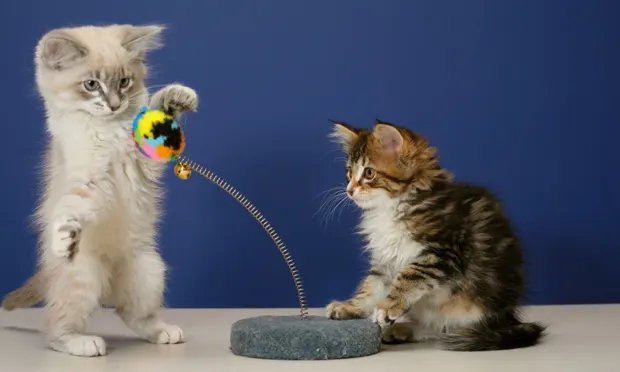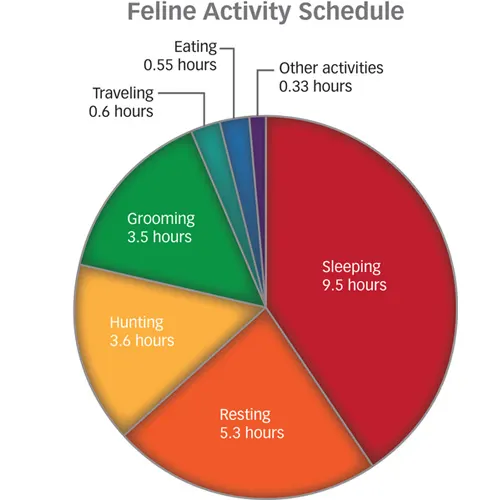Environmental Enrichment for Cats
Lisa Radosta, DVM, DACVB, Florida Veterinary Behavior Service, West Palm Beach, Florida

Why is environmental enrichment important for cats, and what enrichment recommendations can I give to clients?
Most indoor cats live in underenriched environments; this contributes to physiologic stress and behavior disorders such as intercat aggression, urine marking, house soiling, owner-directed aggression, psychogenic alopecia (behavioral overgrooming), and displacement activities. Cats may also show reduced comfort behaviors (eg, grooming, eating, playing, exploring) when under physiologic stress. Variable schedules, decreased interactions with caregivers, and unexpected physical manipulations can increase stress levels and hiding behavior while decreasing activity levels and inhibiting sleep.1

Proper enrichment includes making the environment more physically, socially, and temporally complex by increasing novelty and the opportunity to engage in species-typical behavior. Enrichment should include visual, auditory, olfactory, gustatory, tactile, and structural stimuli2 and be based on the daily activities of free-roaming cats (see Feline Activity Schedule).3
Resting & Hiding Environment
Resting cats observe their environment primarily via sight, sound, and smell. A typical indoor cat rarely has diversity in its environment except for what it can observe through a window. A cat that observes prey outdoors but does not have an outlet for its predatory drive may become frustrated and engage in stress-related displacement behavior and aggression.
Hiding is a normal feline coping behavior. Cats should have tall vertical (eg, cat trees, shelving) and horizontal (eg, crinkle bags, cardboard boxes) spaces within their core area (ie, the most frequented area) so they can separate themselves from stressful interactions. A good guideline is to have one resting space and hiding space per cat in each room that the cat frequents. Hiding and resting areas can be made more enticing through positive reinforcement with catnip or treats.
Proper enrichment includes making the environment more physically, socially, and temporally complex while increasing novelty and the opportunity to engage in species-typical behavior.
Olfactory Environment
Scent signals are an important part of intercat communication and exploration. Cats exposed to novel odors are more active.4 Many substances can provide olfactory stimulation (see Olfactory Stimuli for Cats). However, adding new scents to the environment may worsen urine marking in cats predisposed to or already exhibiting this behavior.
Facial marking or bunting facilitates the spread of scent using the glands around the mouth. Cats may bunt new or prominent items, other animals, and humans. Facial marking devices and toys (eg, Catit Cat Spa) can be affixed to the corners of walls to direct this behavior to appropriate targets.
Cats can be safely exposed to the outdoors with cat harnesses and cat-proofed enclosures. Although many cats do not accept harness walking initially, they can adjust with time.
Scratching vertical or horizontal surfaces is a normal cat behavior that leaves visual and scent signals and removes the cuticle from the nail, but owners dislike the damage caused by scratching. The best solution is to find the cat’s tactile preferences and offer them in accessible places. For example, if the cat is scratching a leather couch, a scratching post with a similar-feeling material should be offered in the same location. Cats can learn to scratch on substrates that are off the beaten path, but they are more likely to be drawn to socially prominent areas. Catnip, food, and positive reinforcement can attract cats to a particular scratching post.
Olfactory Stimuli for Cats
Litterbox Environment
The litterbox environment is especially important to the health and welfare of indoor cats. In general, cats prefer clumping litter5 with sand-like texture in large uncovered boxes (eg, 33 × 15 inches6) placed in quiet, easily accessible locations in their core area. There should be at least one litterbox per cat, but having one more litterbox than the number of cats in the household is ideal.
To avoid excess reactions or aggression when playing with laser pointers, owners should end the session by pointing the laser at a toy the cat can “kill” before turning off the laser.
Social Environment
Although cats have been labeled as solitary animals, they can have preferred associates, participate in mutual grooming and rubbing, form stable family groups, sleep in contact with other animals or humans, and maintain a social organization when food resources are adequate.7-10 Humans and dogs may be adequate social contact for cats in single-cat households.
The ideal cat density in a given space depends on the abundance of food11 and level of enrichment. Recommendations range from 107 sq ft per cat12 to at least 2 rooms.13 Male cats may need more space (4–5 rooms), whereas female cats may be happy with less (3–3.5 rooms). It is vitally important that number of food and water bowls, litterboxes, and resting areas be increased with each cat added to the household.
Training cats to do tricks offers benefits beyond entertaining guests. It allows cats to use mental energy and facilitates bonding with the trainer. Training sessions should be no longer than 3 minutes, held before feeding, and terminated while the cat is still driven to interact. In addition, high-value rewards should be used, and cats should be trained individually. Clicker training can be highly effective.
Hunting, Play, & Gustatory Environment
Although predatory behavior can be influenced by hunger, it is not solely reliant on it—cats that are satiated maintain the drive to hunt. The elements of hunting (ie, seeking, capturing, killing, consuming) appear to be independent of each other,14 suggesting that some of these elements serve a purpose beyond satiating the cat.
Predatory behavior can be stimulated by dividing the cat’s daily ration and feeding in multiple places in the home, hiding food under furniture and rugs, providing ways to satisfy the need to chew (eg, beef jerky, cat-safe grass), and feeding from food toys (eg, IQ Treat Ball; Kitty Kong).
Owners should keep a wide variety of toys (see Toys, Toys, Toys!) on hand and rotate them so that each cat receives 3 different or new toys per day; cats habituate to toys in 3 short sessions but will have renewed interest if even the color of a toy is changed.15 Smaller toys and mobile toys with complex surfaces tend to increase play.16 Cats benefit from structured play sessions with owners just as dogs benefit from daily structure and enrichment (eg, daily walks). Training can be mixed in with play to further enhance the cat’s bond with the owner.
Some cats may become overly reactive or aggressive when playing with laser pointers; to remedy this, owners should point the laser at a toy that the cat can “kill” before turning off the laser.
Toys, Toys, Toy!
Toys do not need to be expensive or high tech.
Examples of inexpensive cat toys include:
A ping pong ball in a bathtub
Toys on wands
Toys on stands
Egg cartons with treats hidden inside
Laser pointers or toys (frolicat.com)
Toys that move or make lifelike noises
Plastic rings from milk cartons
Balled up pieces of paper
Catnip mice or balls
Balls with bells
Aquariums stocked with fish
Used hair bands or large fabric hair ties
Some toys listed here may pose obstruction risk; supervision is advised. |
In Closing
With proper attention to the environment, indoor pet cats can live as enriched a life as an outdoor cat while enjoying the health benefits and longevity only available to an indoor cat.